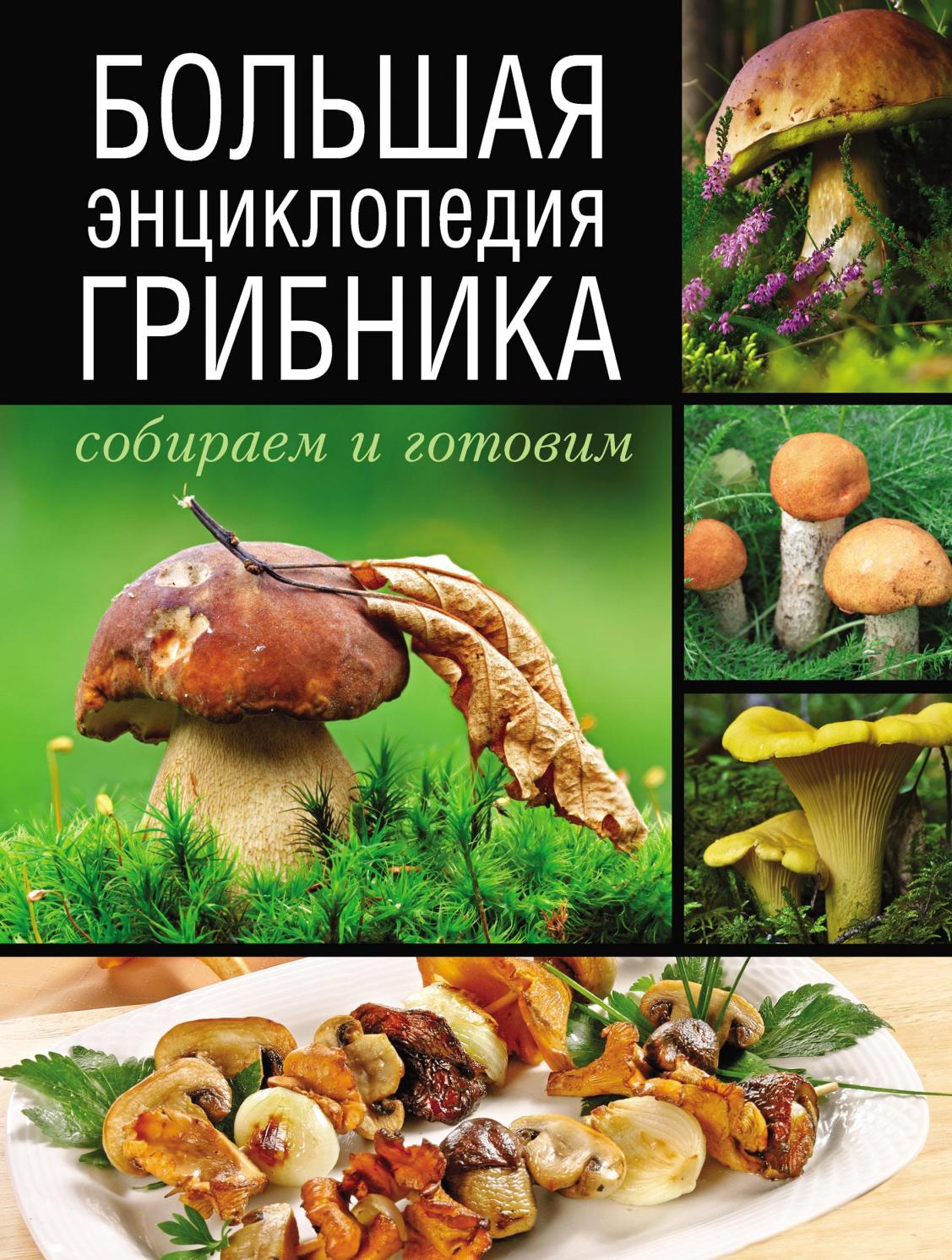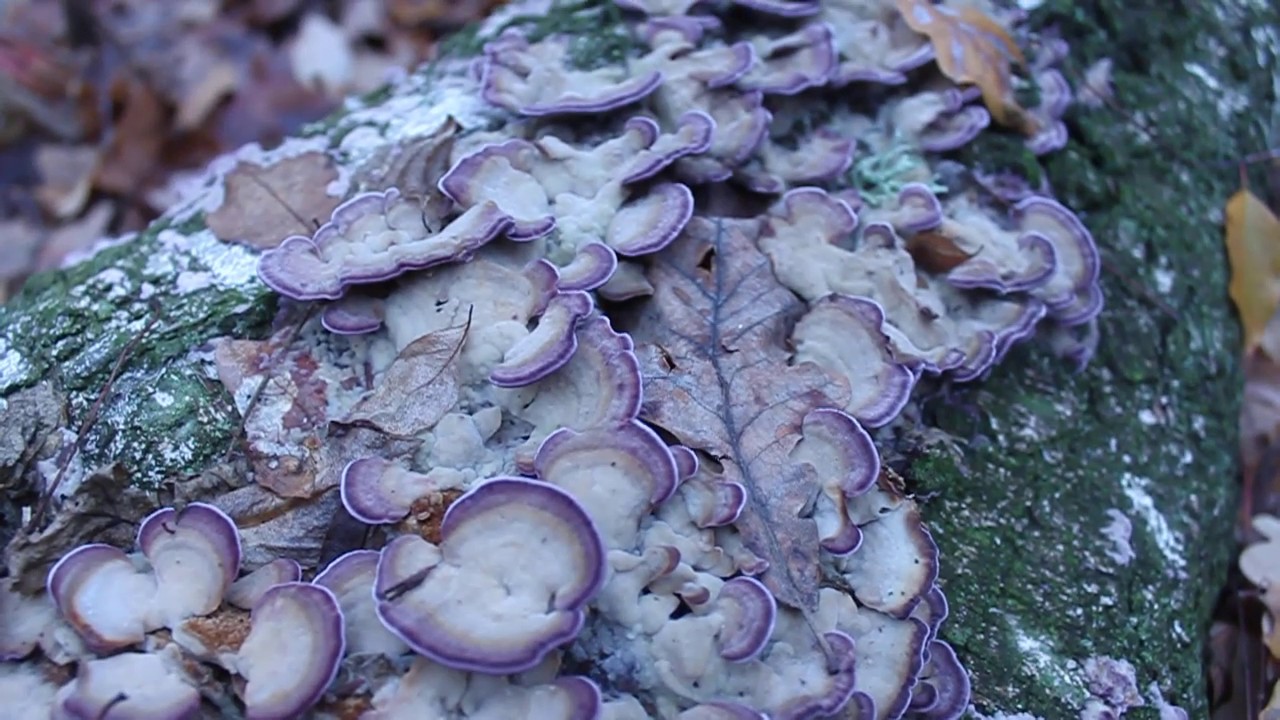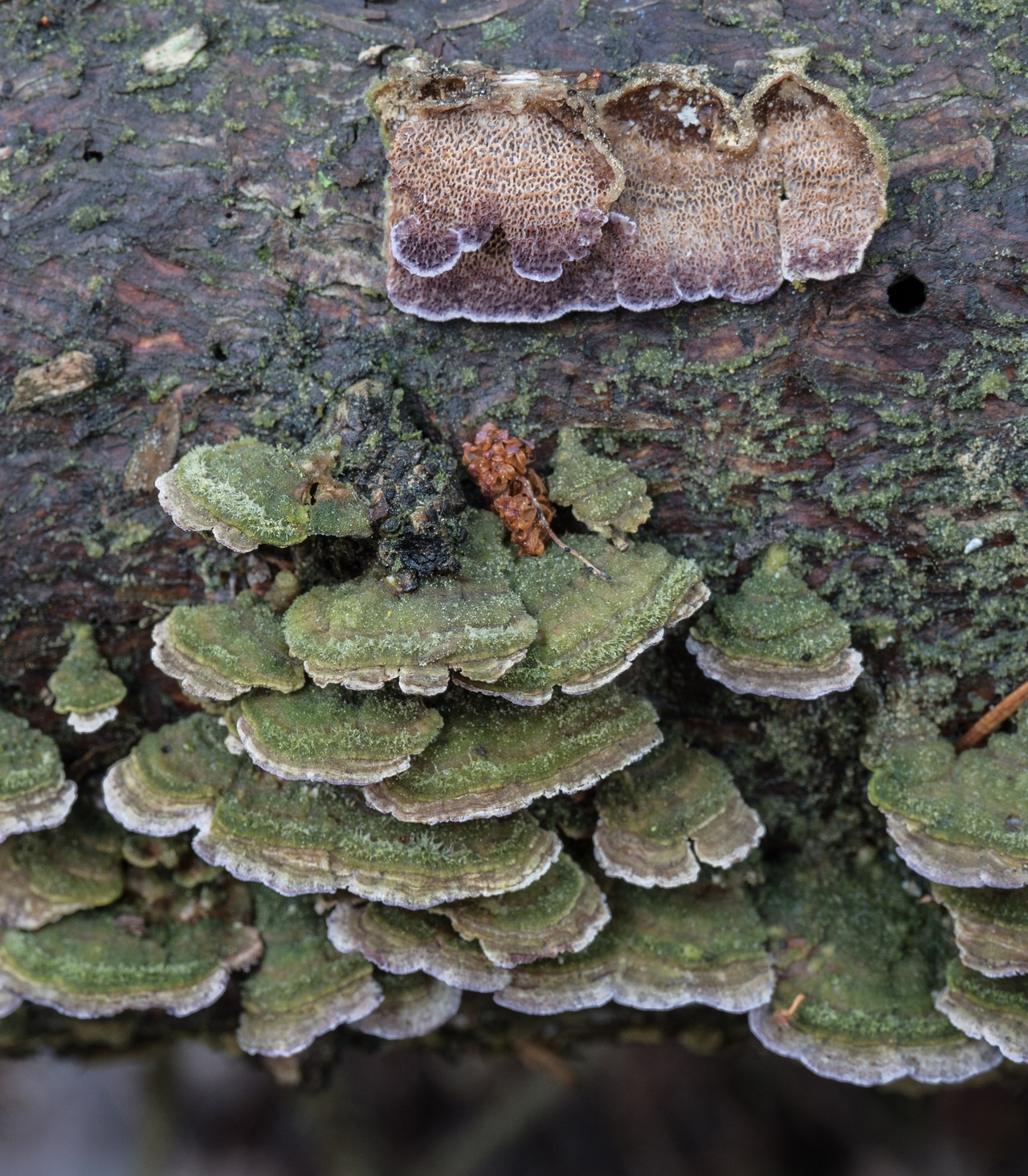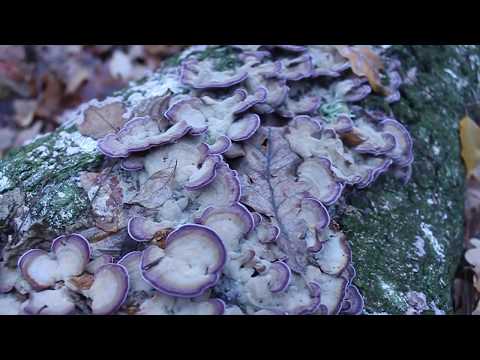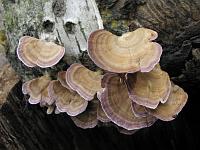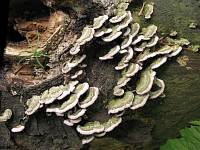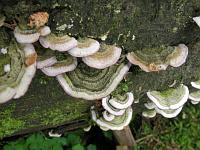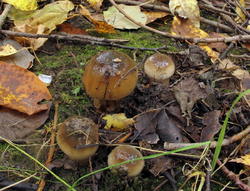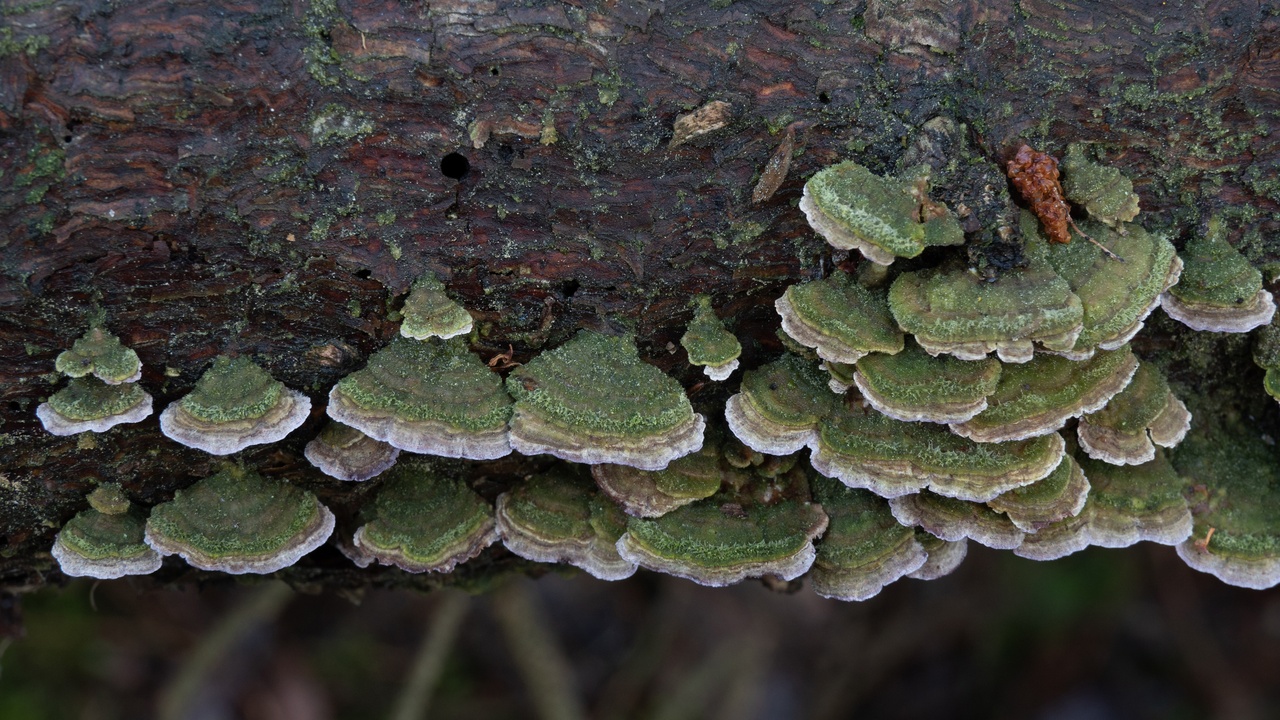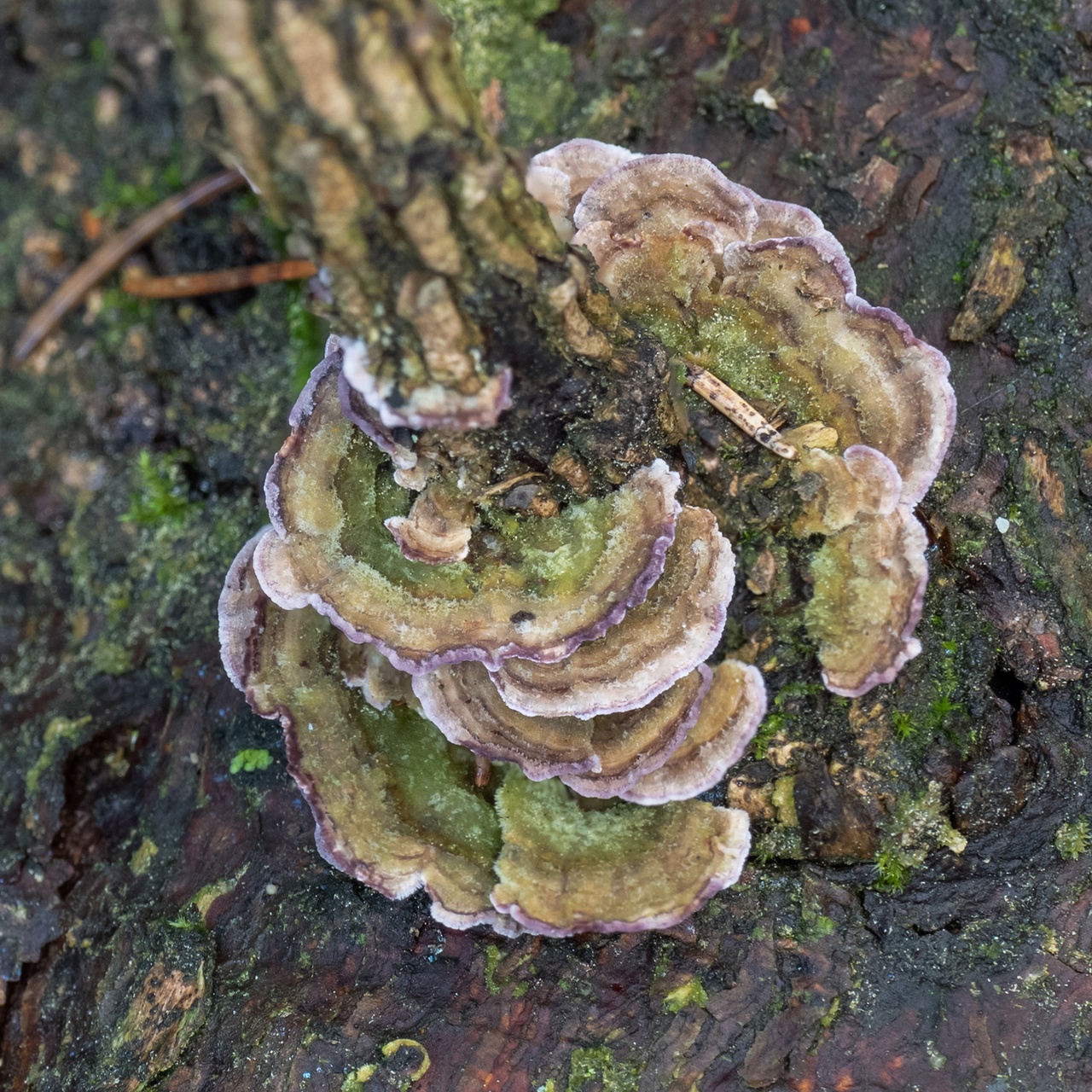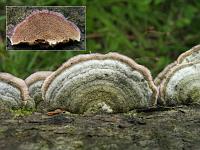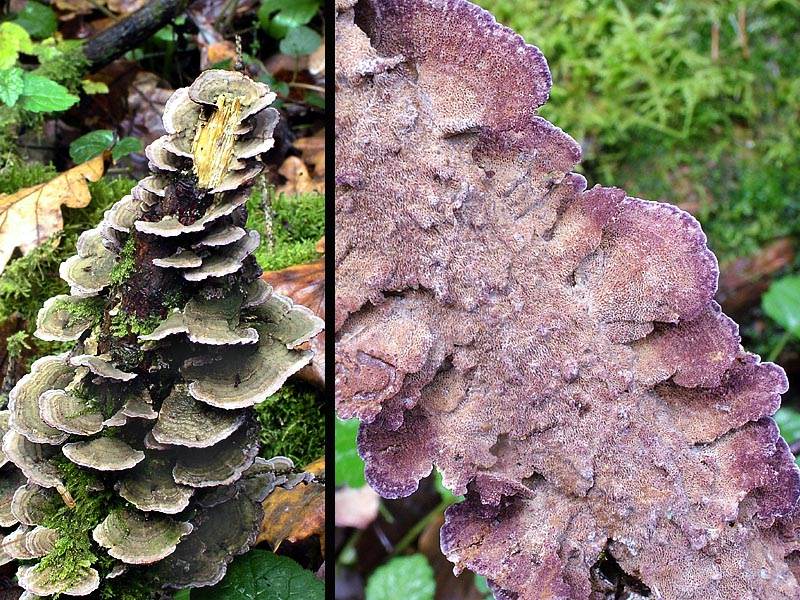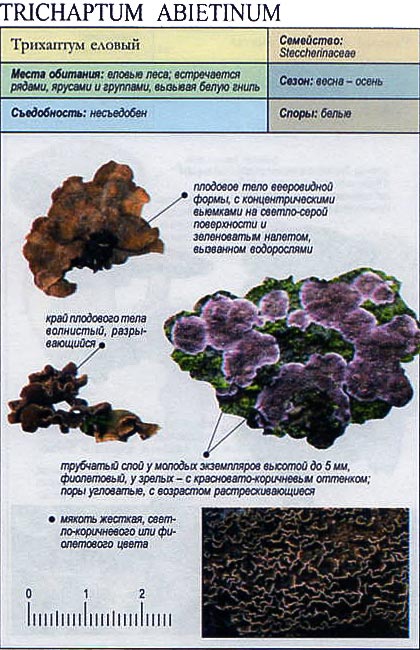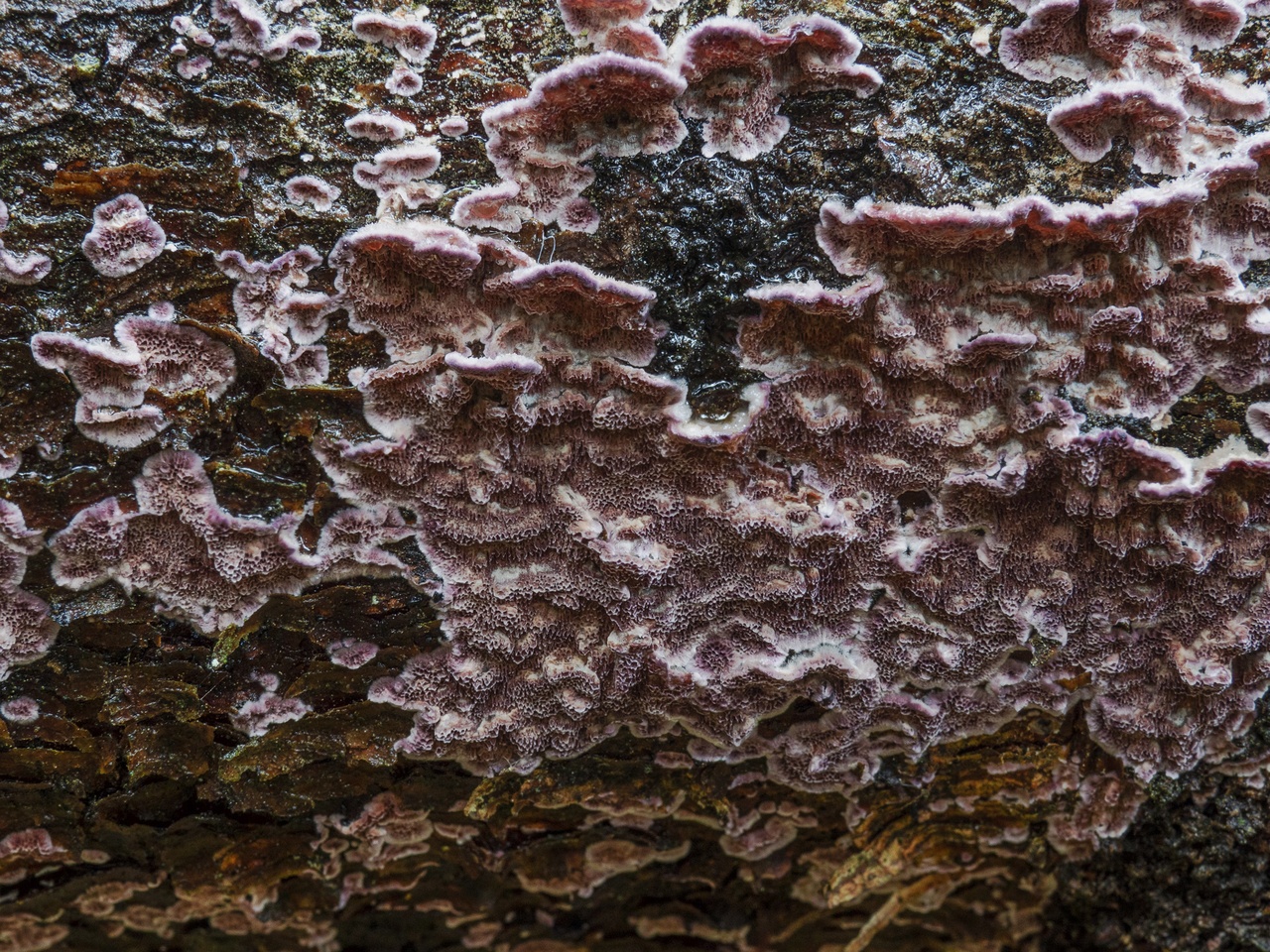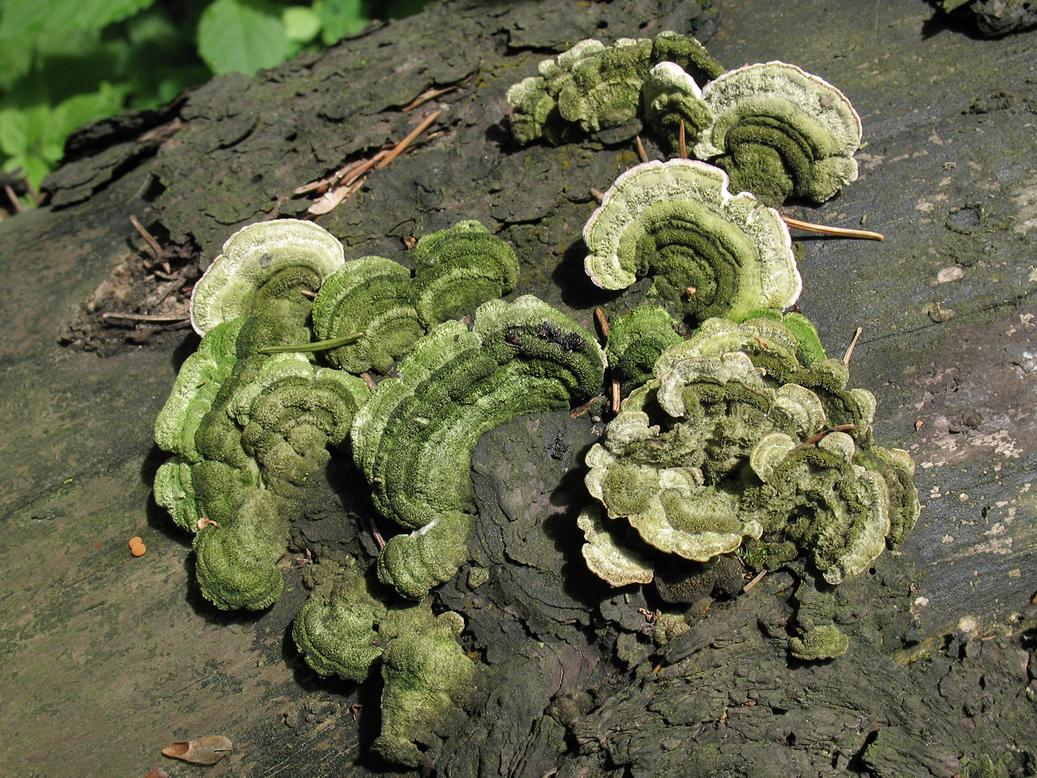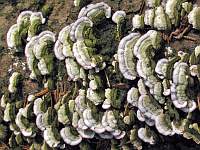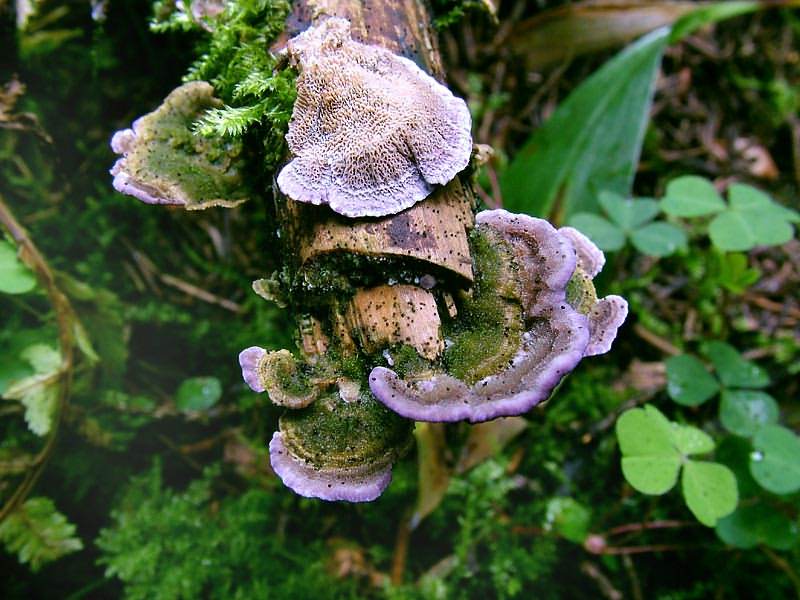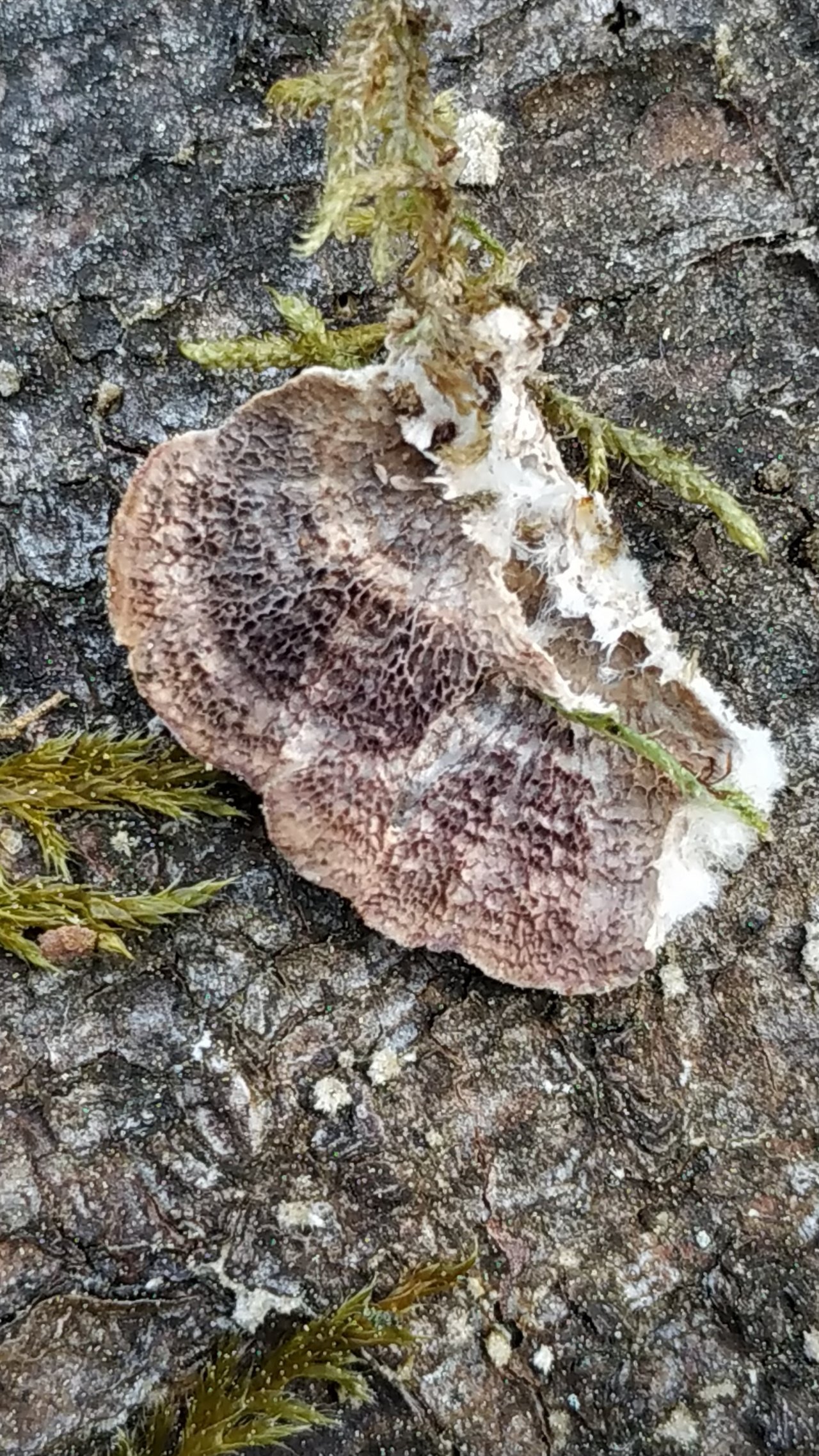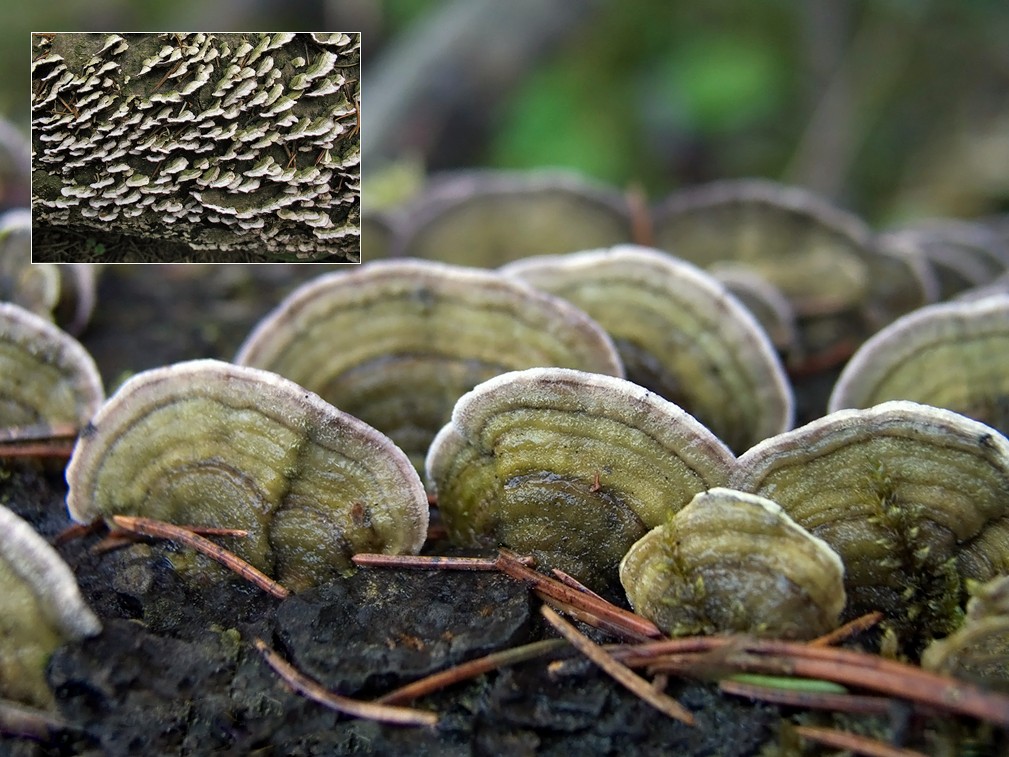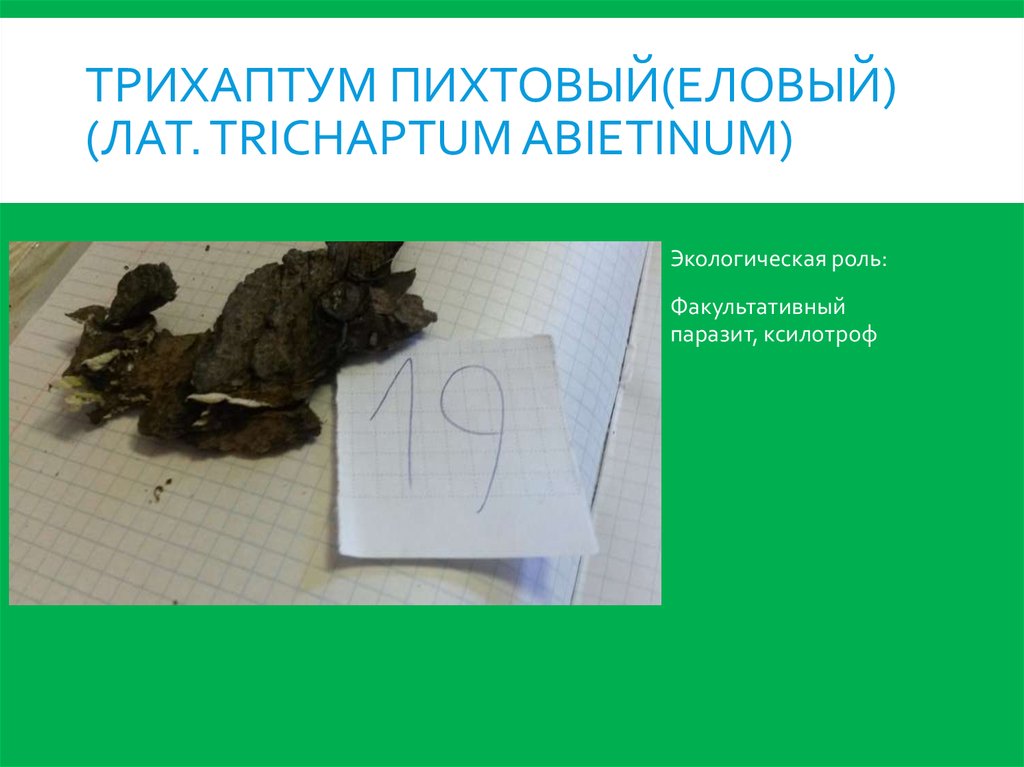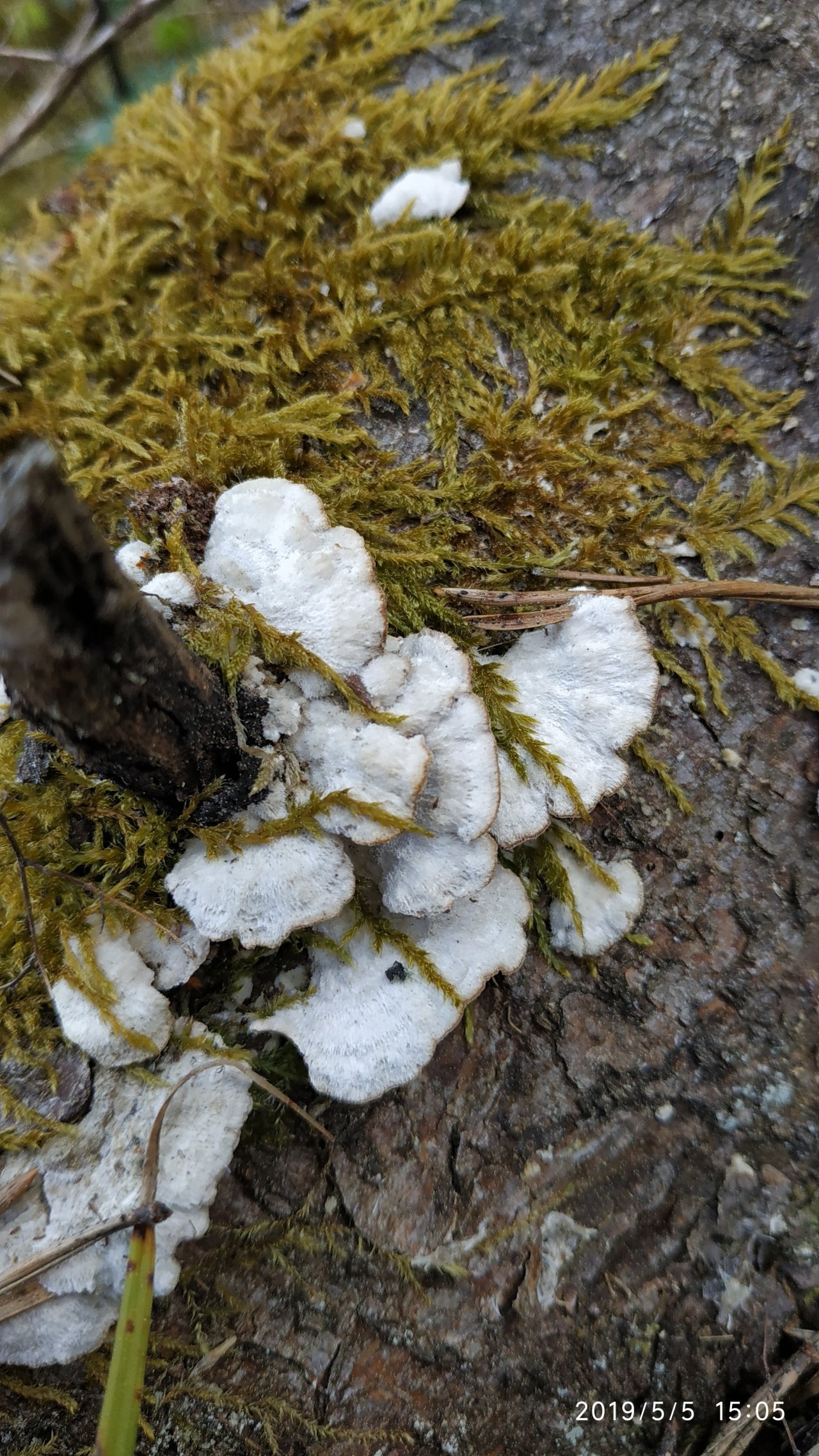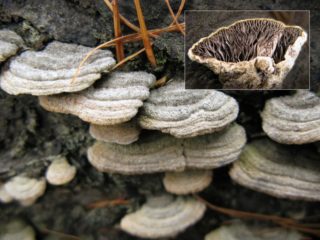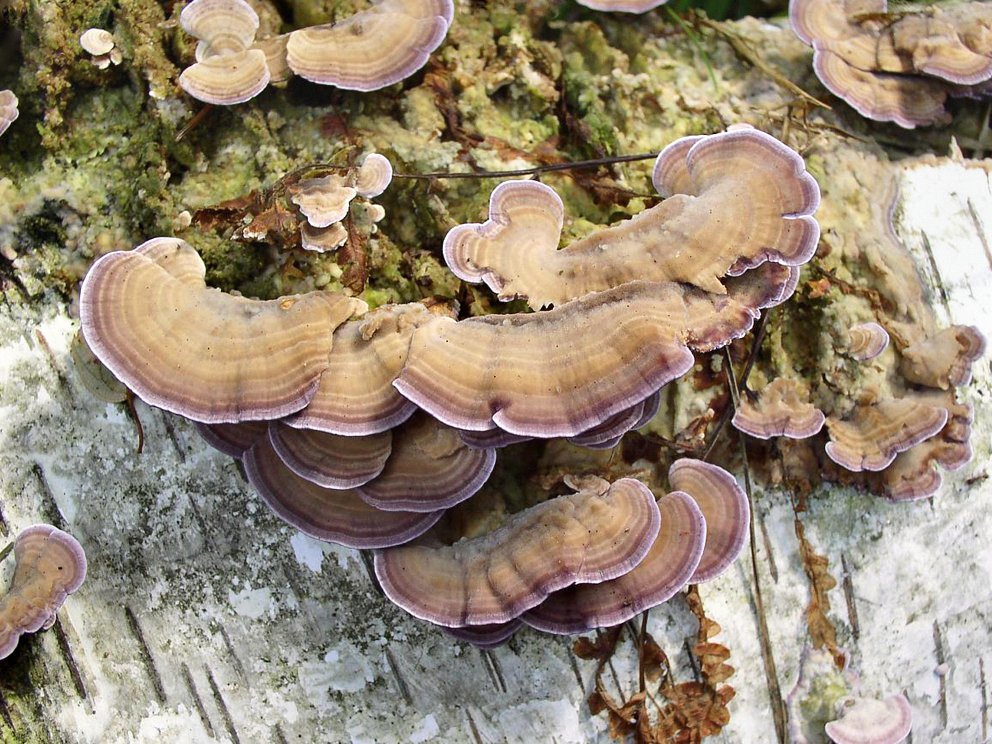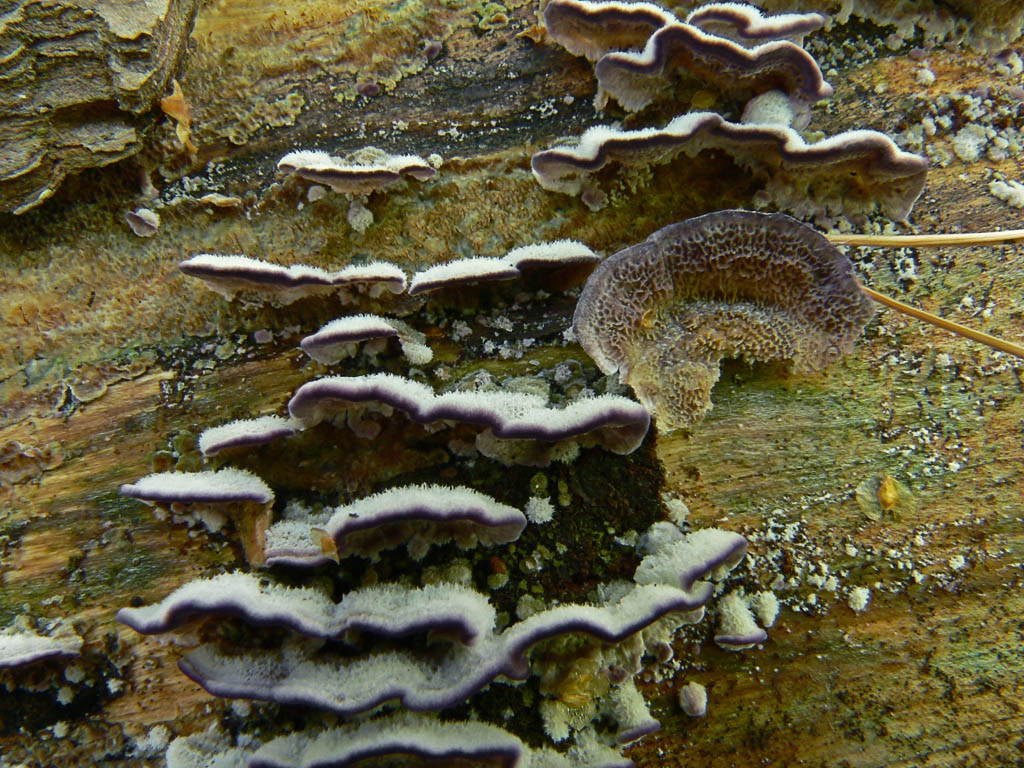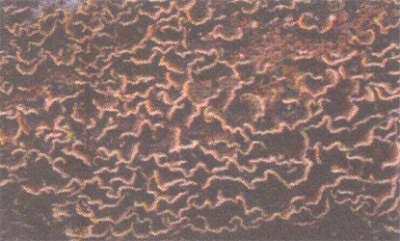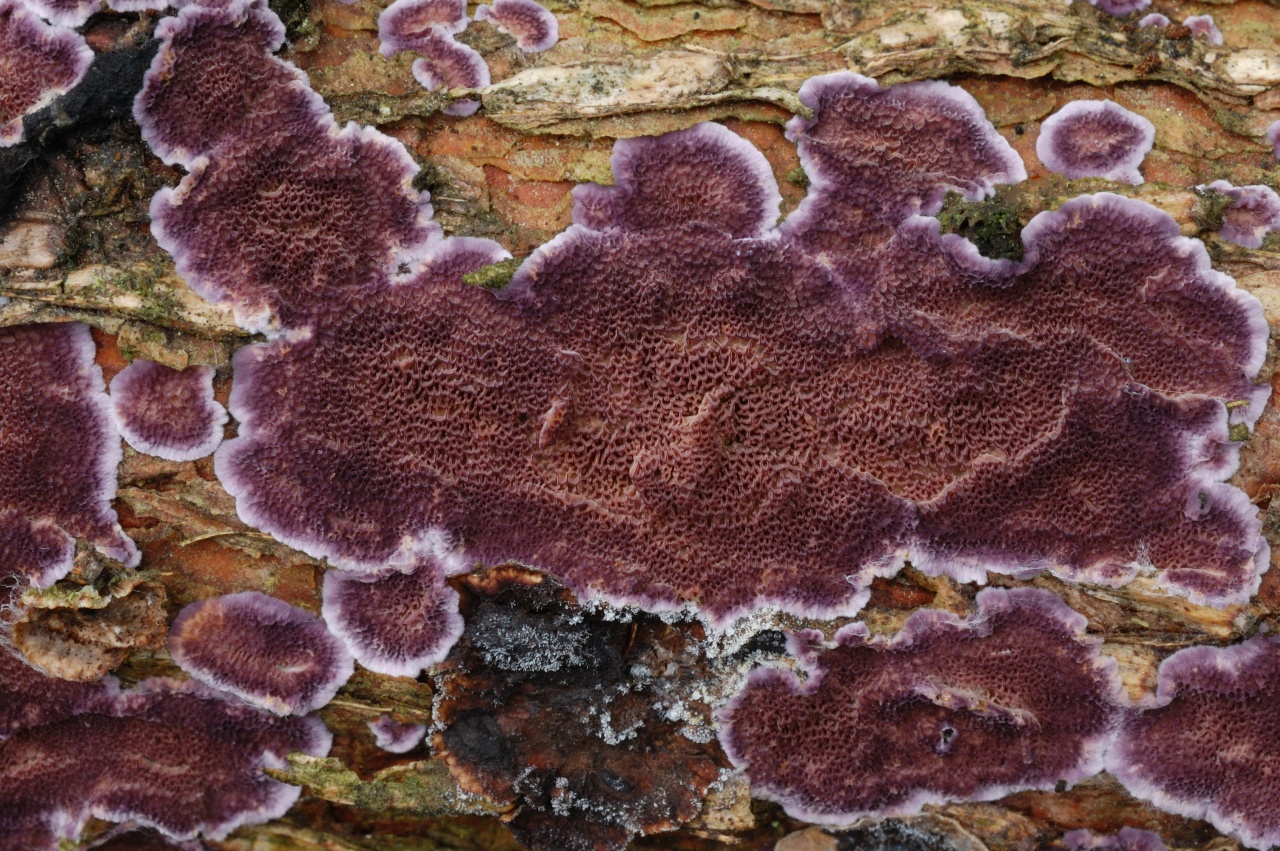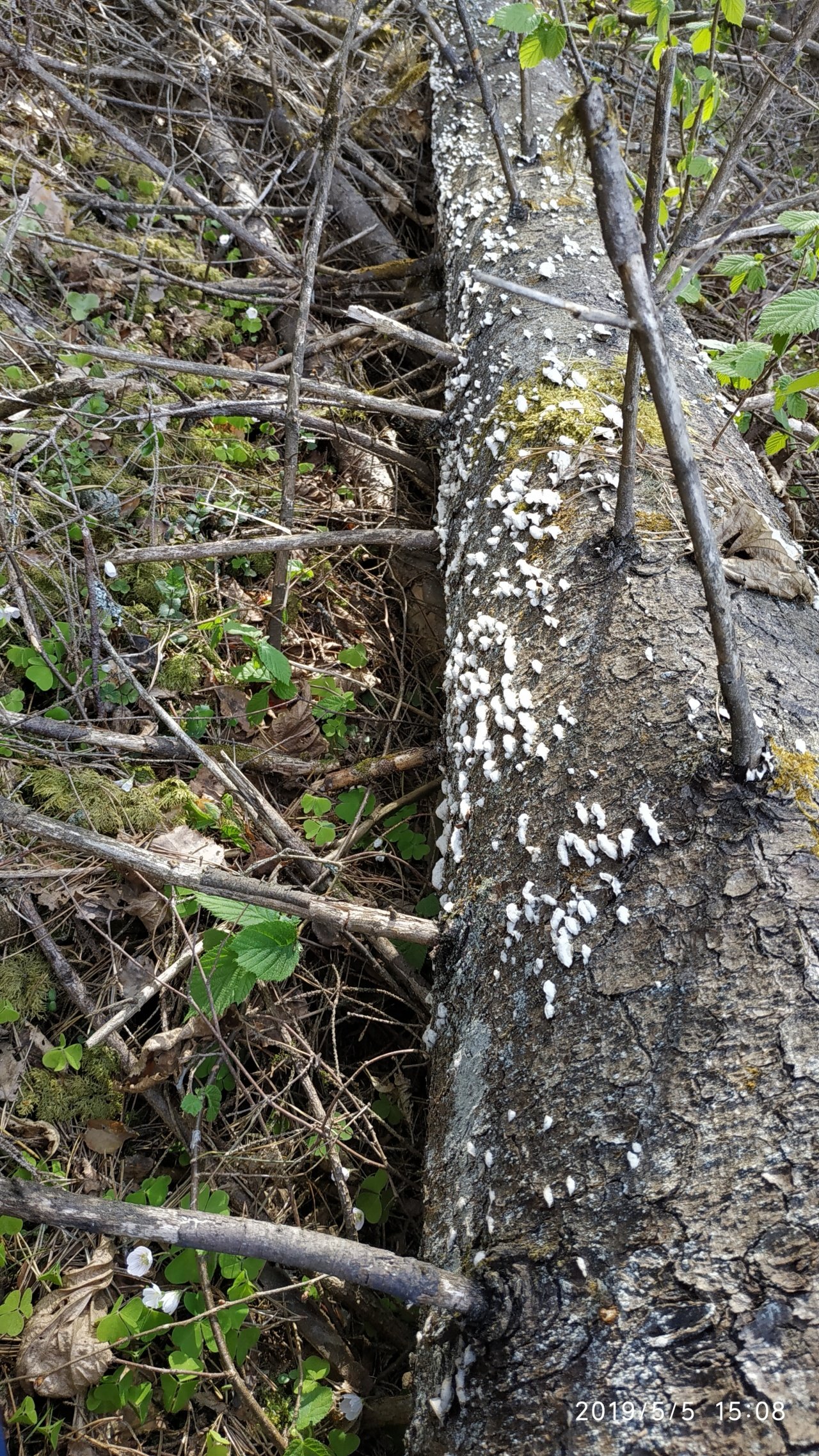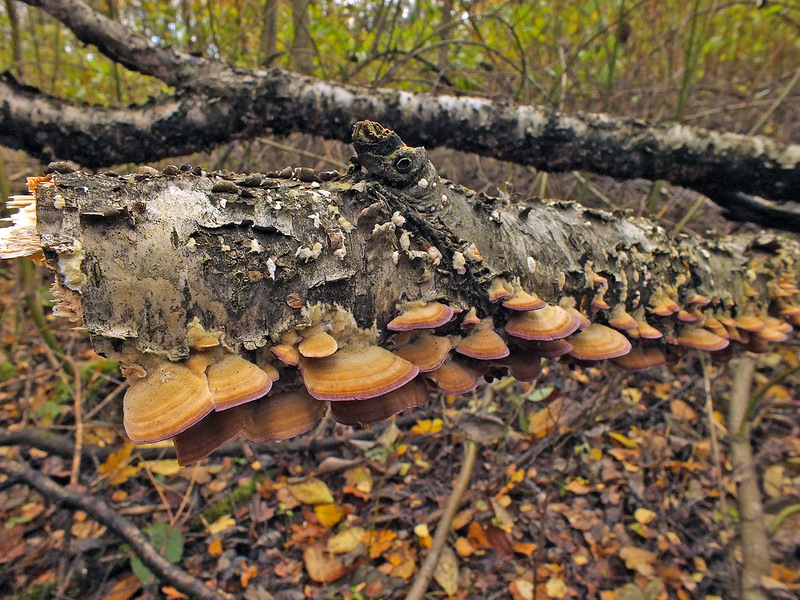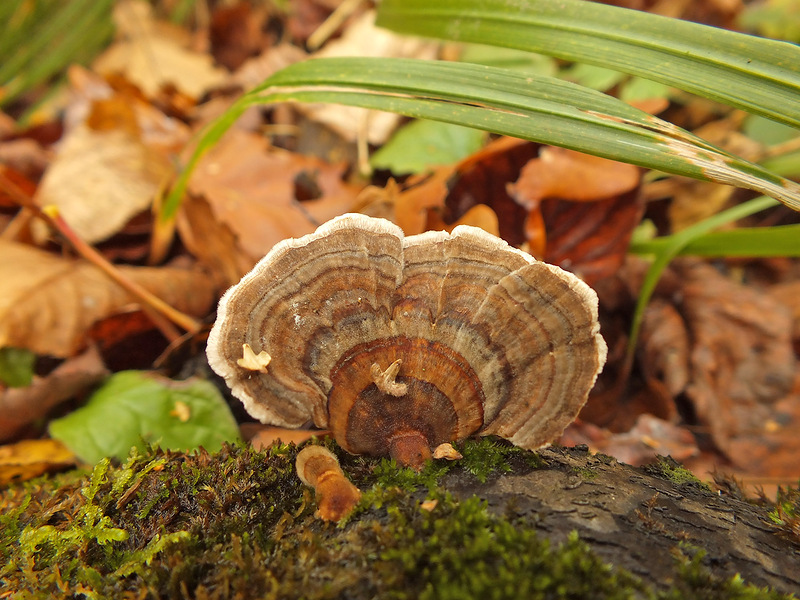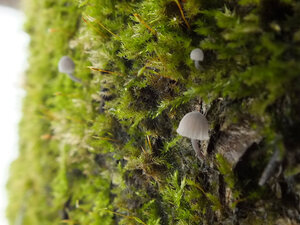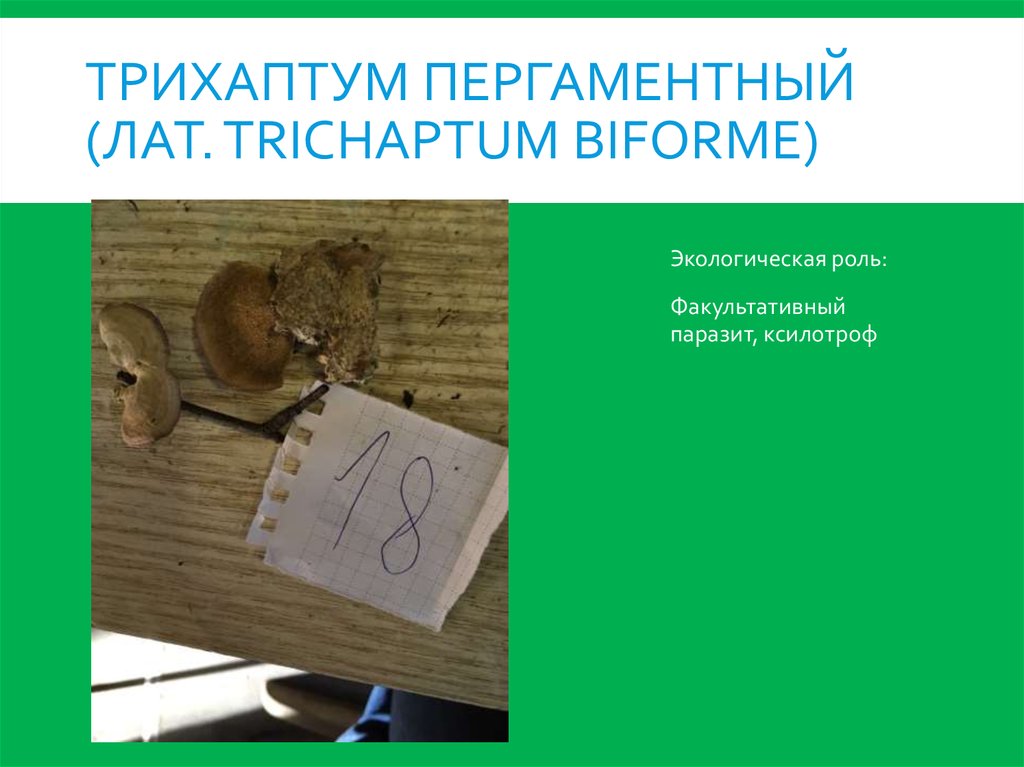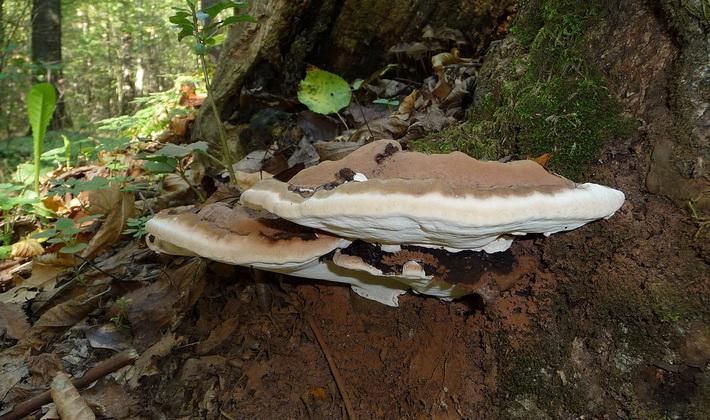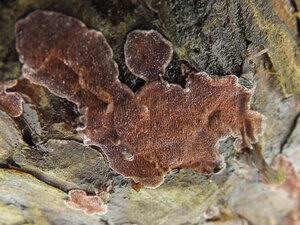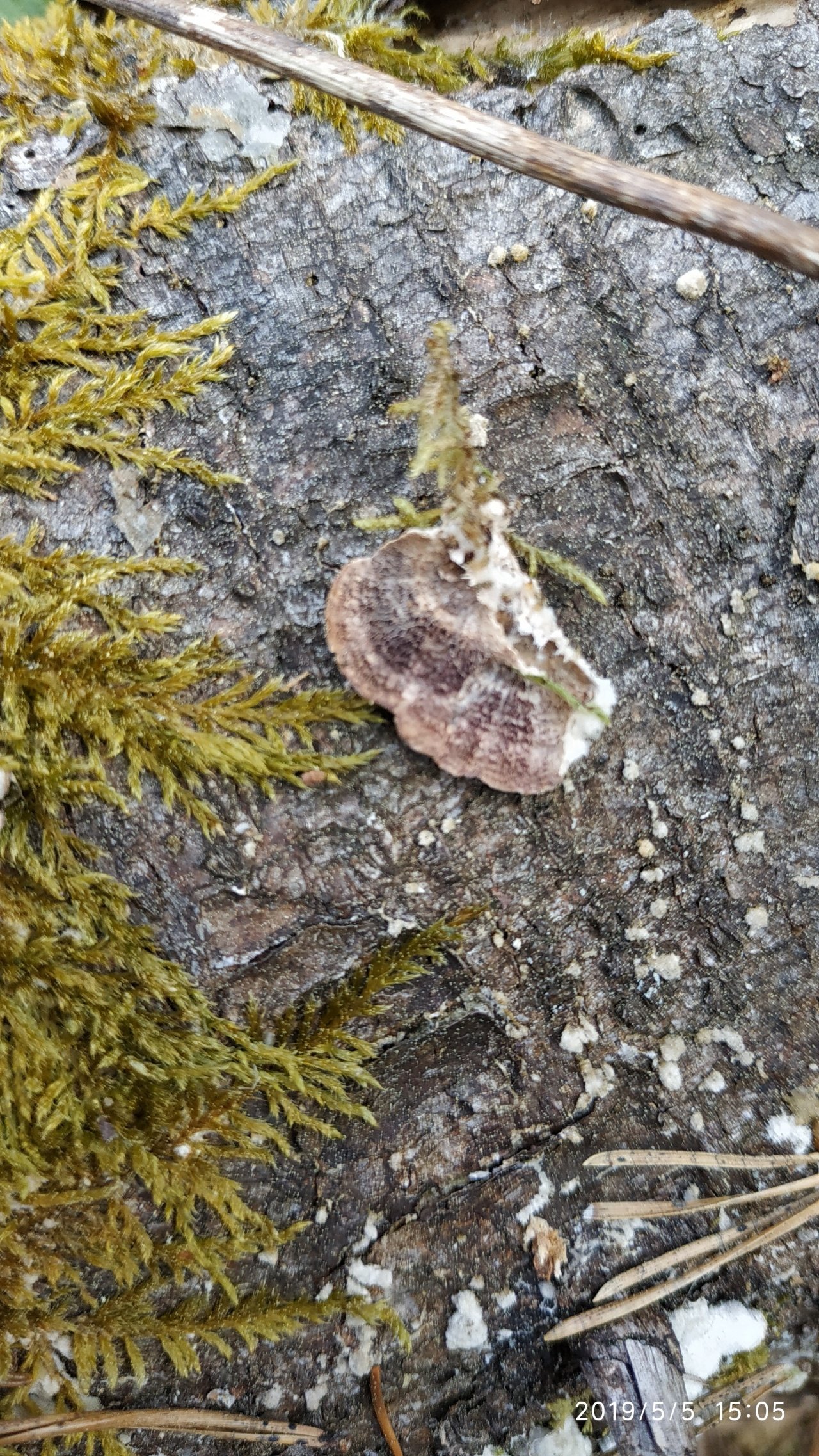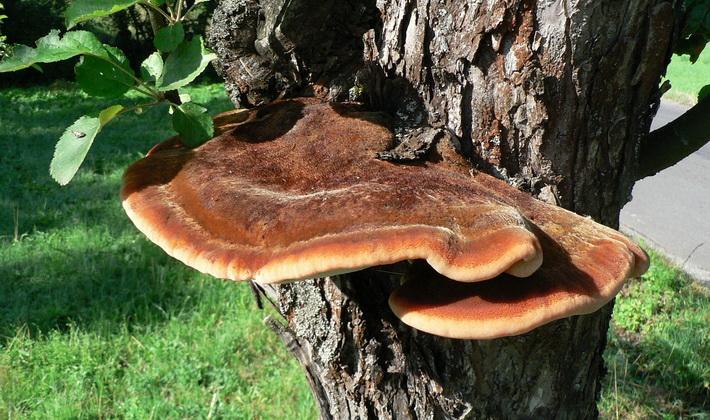Trichaptum biforme

Current title
| Index Fungorum | Trichaptum biforme (Fr.) Ryvarden | |
| MycoBank | Trichaptum biforme (Fries) Ryvarden |
Systematic position
Etymology of the species epithet
Biformis, e having two images, two-shaped, two-faced. From bis- twice, twice or doubly + -formis, e, species, form.
Synonyms
- Polyporus biformis Fr., in Klotzsch, Linnaea 8: 486 (1833)
- Polystictus biformis (Fr.) Fr., Nova Acta R. Soc. Scient. upsal., Ser. 3 1 (1): 84 (1851)
- Bjerkandera biformis (Fr.) P. Karst., Bidr. Känn. Finl. Nat. Folk 37: 44 (1882)
- Coriolus biformis (Fr.) Pat., Cat. Rais. Pl. Cellul. Tunisie (Paris): 48 (1897)
- Microporus biformis (Fr.) Kuntze, Revis. gen. pl. (Leipzig) 3 (2): 495 (1898)
- Trametes biformis (Fr.) Pilát, in Kavina & Pilát, Atlas Champ. l'Europe, III, Polyporaceae (Praha) 1: 277 (1939)
- Hirschioporus friesii (Klotzsch) D.A. Reid, Contr. Bolus Herb. 7:59 (1975)
- Coriolus prolificans (Fr.) Murrill, N. Amer. Fl. (New York) 9 (1): 27 (1907)
- Trichaptum pargamenum (Fr.) G. Cunn., Bull. N.Z. Dept. Sci. Industr. Res., Pl. Dis. Div. 164: 100 (1965)
- Spongipellis laceratus (Berk.) Pat., Essai Tax. Hyménomyc. (Lons-le-Saunier): 84 (1900)
- Hirschioporus elongatus (Berk.) Teng, Chung-kuo Ti Chen-chun,: 761 (1963)
- Polyporus menandianus Mont., Annls Sci. Nat., Bot., Sér. 2 20: 362 (1843)
- Microporus inquinatus (Lév.) Kuntze, Revis. gen. pl. (Leipzig) 3 (2): 496 (1898)
- Microporus evolvens (Berk.) Kuntze, Revis. gen. pl. (Leipzig) 3 (2): 496 (1898)
- Microporus candicans (Lév.) Kuntze, Revis. gen. pl. (Leipzig) 3 (2): 495 (1898)
- Coriolus sartwellii (Berk. & M. A. Curtis) Murrill, Bull. Torrey bot. Club 32 (12): 646 (1905)
- Polyporus pseudopargamenus Thüm., Mycoth. Univ., Cent. 12: no. 1102 (1878)
- Polystictus hodgkinsoniae (Kalchbr.) Rick, in Rambo (Ed.), Iheringia, Sér. Bot. 7: 246 (1960)
- Polyporus ehretiae Bres., Stud. Trent., Classe II, Sci. Nat. Econ. 7 (1): 56 (1926)
- Polystictus sublimitatus (Murrill) Murrill, Bull. Torrey bot. Club 65: 661 (1938)
Habit
Fruit body: Sedentary, cantilever, hoof-shaped, in the form of an irregular growth or rosette
- Hymenophore: Tubular, porous
- Hymenophore: Thorny
Fruiting body
Fruiting bodies are annual, sessile, prostrate-bent or prostrate, taper towards the base, thin, elastic, leathery; on the side surfaces of tree trunks - fan-shaped, up to 50 mm in diameter and 6 mm thick; are arranged in tiled groups, grow together, form rosettes on the upper surfaces, they may not form lobes on the lower surfaces, forming only a hymenophore layer. The surface is short tomentose, silky, with time it becomes almost naked, with concentric zones. The color changes over time: first lilac, violet, then, starting from the base, turns pale, acquires a light yellow-brown color. Algae and cyanobacteria settle on old fruit bodies, which color the fungi green. The edge is thin, sharp, often lobed, retains its purple color for a long time.
The hymenophore is tubular, the tubules are very short, up to 0.5 mm long, over time they lengthen up to 5 mm, the walls collapse and the hymenophore acquires a prickly, dissected-toothed (irpexoid) appearance. The surface of the hymenophore is lilac or purple, fades over time, in old and dead fruiting bodies it completely fades to a brownish-yellowish color. The pores of young fruit bodies are round or oblong, small - 0.2 - 0.3 mm in diameter, on average 3 - 4 pcs. by 1 mm.
Pulp
The pulp is fibrous-leathery, white or beige.
Microscopy
Spores 6 - 7 × 2 - 2.5 μm, allantoid.
Basidia 12 - 22 × 4 - 5.5 μm, clavate.
Cystids 20 - 35 × 3 - 5 µm, abundant, slightly thick-walled, fusiform, inlaid in the upper part, with a buckle at the base.
The hyphae system is dimitic. Generative hyphae are thin-walled, with buckles, sometimes branched, 2.5 - 7 µm in diameter. Skeletal hyphae are thick-walled, rarely branched, 3 - 6 µm in diameter.
Ecology and distribution
Grows on dead and dead, often burnt trunks of deciduous trees, prefers birch (Betula), but also occurs on aspen (Populus tremula), alder (Alnus), rarely on hornbeam (Carpinus), beech (Fagus), oak (Quercus) , noted as an exception in conifers. Causes white rot.
Biological description
Fruiting bodies are annual, sometimes overwintering, capped or nearly spread, often tiled and accrete. The upper surface of the cap is covered with tomentose, then bare, with concentric zones, initially lilac, then whitish. The edge of the cap stays purple longer. The fabric is whitish, thin, up to 1 mm thick.
The hymenophore is initially tubular; the tubules often split, taking the form of irregular convolutions. The color is lilac-violet, then fades to yellowish-brownish.
The hyphae system is dimitic. Hymenophore hyphae are usually thin-walled, septate, with buckles. Gypha trams are thick-walled, unbranched. Basidia are tetrasporous, 12–17 × 4.5–6 µm. Cystids are fusiform, 16-29 × 4-6 µm. The spores are cylindrical, uncolored, 5-7 × 2-2.5 µm.
Trichaptum does not contain any poisonous substances, however, its tough thin fruiting bodies do not allow it to be counted among edible mushrooms.
Similar species
On conifers, there are two other widespread species of the genus, fir trichaptum and brown-violet trichaptum. On the beech there is a very rare type of filmy trichaptum, distinguished by thicker fruiting bodies and blackish zones on adult caps.
Cooking edible fern
Bracken is a healthy and tasty plant that is widely used in oriental cuisine. It can be used to prepare salads, soups, snacks, stews and fried dishes. Shoots of young fern go well with rice, noodles, vegetables, meat and seafood. Bracken has a positive effect on the digestion process, is rich in vitamins, besides, its calorie content is quite low - 34 kcal.
Interesting! Fried fern is especially popular - this method of preparation helps to preserve the taste and crispness of the shoot.
Roasted fern recipes
In almost all recipes, you can cook fresh, frozen, dried and salted ferns. You just need to take into account some of the nuances: it is recommended to soak dried pagons in warm water for several hours, salted ones - it is necessary to rinse thoroughly.
With onion
Cut 2 medium onions into half rings, fry in vegetable oil until golden brown, add 500 g of boiled fern cut into small pieces to a frying pan, fry for a few minutes. This is a simple yet delicious dish. If desired, you can add carrots, season with sour cream and mayonnaise. Seasoned with soy sauce for a Korean-style fern.
Fern dishes
With potato
300 g of boiled sprouts must be fried until crispy, put on a plate. Put 500 grams of potatoes, cut into long pieces, in a frying pan, fry until tender. Season with salt, pepper, add prepared fern. If desired, you can add onions, garlic. The potato takes on a delicious mushroom flavor.
With meat
The meat is cut into thin slices, marinated with salt, pepper, soy sauce. Onions are cut in half rings, fried in vegetable oil, put on a plate. The meat is laid out in a frying pan, fried until golden brown, and brought to half-readiness.
Prepared shoots are placed on the meat, onions are added. If you wish, you can put out the dish with sour cream or soy sauce, add sesame seeds.
If the fern is bitter
In the process of cooking rachis, you can face a common problem - the fern tastes bitter, radically changing the taste of the dish. How easy is it to remove bitterness from a fern? It's very simple: soak the shoots for several hours in salted water, change the water a couple of times.
Then rinse the pagons well and boil them for 6-9 minutes with the addition of salt. Such sprouts are ready for consumption or further harvesting and storage.
The bracken fern is not only a beautiful plant. It can be grown at home, used to decorate an alpine slide or a corner in the garden. In addition, the culture is valued for its beneficial properties and is used in medicine. Bracken is an edible fern, delicious dishes are prepared from it, fried, pickled, harvested for the winter.
Taxonomy
Trichaptum in two was first described by Elias Magnus Fries in 1833 as a composite genus of hard tree fungi with a tubular hymenophore. Later described by him under several other names. In 1965, for the first time transferred to the genus Trichaptum, since 1972 known by its modern name.
Synonyms
- Bjerkandera biformis (Fr.) P. Karst., 1882
- Coriolus biformis (Fr.) Pat., 1897
- Coriolus elongatus (Berk.) Pat., 1900
- Coriolus friesii (Klotzsch) Pat., 1900
- Coriolus laceratus (Berk.) Pat., 1900
- Coriolus pergamenus (Fr.) G. Cunn., 1950
- Coriolus prolificans (Fr.) Murrill, 1907
- Coriolus sartwellii (Berk. & M.A. Curtis) Murrill, 1905
- Coriolus simulans (Błoński ex Sacc.) P. Karst., 1904
- Coriolus sublimitatus Murrill, 1938
- Heteroporus pergamenus (Fr.) Bondartsev & Singer, 1941
- Hirschioporus elongatus (Berk.) Teng, 1963
- Hirschioporus friesii (Klotzsch) D.A. Reid, 1975
- Hirschioporus pergamenus (Fr.) Bondartsev & Singer, 1941
- Irpex elongatus (Berk.) Lloyd, 1923
- Leucoporus xalapensis (Berk. & M.A. Curtis) Pat., 1903
- Microporellus friesii (Klotzsch) Ryvarden, 1972
- Microporus biformis (Fr.) Kuntze, 1898
- Microporus candicans (Lév.) Kuntze, 1898
- Microporus elongatus (Berk.) Kuntze, 1898
- Microporus evolvens (Berk.) Kuntze, 1898
- Microporus friesii (Klotzsch) Kuntze, 1898
- Microporus inquinatus (Lév.) Kuntze, 1898
- Microporus laceratus (Berk.) Kuntze, 1898
- Microporus pergamenus (Fr.) Kuntze, 1898
- Microporus prolificans (Fr.) Kuntze, 1898
- Microporus sartwellii (Berk. & M.A. Curtis) Kuntze, 1898
- Microporus simulans (Błoński ex Sacc.) Kuntze, 1898
- Microporus xalapensis (Berk. & M.A. Curtis) Kuntze, 1898
- Polyporus biformis Fr., 1833basionym
- Polyporus ehretiae Bres., 1926
- Polyporus elongatus Berk., 1842
- Polyporus evolvens Berk., 1856
- Polyporus friesii Klotzsch, 1833
- Polyporus inquinatus Lév., 1846
- Polyporus laceratus Berk., 1839
- Polyporus menandianus Mont., 1843
- Polyporus pergamenus Fr., 1838
- Polyporus prolificans Fr., 1838
- Polyporus pseudopargamenus Thüm., 1878
- Polyporus sartwellii Berk. & M.A. Curtis, 1872
- Polyporus simulans Błoński, 1889, nom. illeg.
- Polyporus xalapensis Berk. & M.A. Curtis, 1849
- Polystictus biformis (Fr.) Fr., 1851
- Polystictus candicans Lév., 1863
- Polystictus elongatus (Berk.) Fr., 1851
- Polystictus evolvens (Berk.) Cooke, 1886
- Polystictus friesii (Klotzsch) Cooke, 1886
- Polystictus inquinatus (Lév.) Cooke, 1886
- Polystictus laceratus (Berk.) Fr., 1851
- Polystictus pergamenus (Fr.) Cooke, 1886
- Polystictus prolificans (Fr.) Fr., 1851
- Polystictus sartwellii (Berk. & M.A. Curtis) Cooke, 1886
- Polystictus simulans Błoński ex Sacc., 1891
- Polystictus sublimitatus (Murrill) Murrill, 1938
- Polystictus xalapensis (Berk. & M.A. Curtis) Fr., 1851
- Spongipellis laceratus (Berk.) Pat., 1900
- Trametes biformis (Fr.) Pilát, 1939
- Trametes friesii (Klotzsch) G. Cunn., 1965
- Trametes pergamena (Fr.) Kotl. & Pouzar, 1957
- Trichaptum pergamenum (Fr.) G. Cunn., 1965
Taxonomy
Trichaptum in two was first described by Elias Magnus Fries in 1833 as a composite genus of hard tree fungi with a tubular hymenophore. Later described by him under several other names. In 1965, for the first time transferred to the genus Trichaptum, since 1972 known by its modern name.
Synonyms
- Bjerkandera biformis (Fr.) P. Karst., 1882
- Coriolus biformis (Fr.) Pat., 1897
- Coriolus elongatus (Berk.) Pat., 1900
- Coriolus friesii (Klotzsch) Pat., 1900
- Coriolus laceratus (Berk.) Pat., 1900
- Coriolus pergamenus (Fr.) G. Cunn., 1950
- Coriolus prolificans (Fr.) Murrill, 1907
- Coriolus sartwellii (Berk. & M.A. Curtis) Murrill, 1905
- Coriolus simulans (Błoński ex Sacc.) P. Karst., 1904
- Coriolus sublimitatus Murrill, 1938
- Heteroporus pergamenus (Fr.) Bondartsev & Singer, 1941
- Hirschioporus elongatus (Berk.) Teng, 1963
- Hirschioporus friesii (Klotzsch) D.A. Reid, 1975
- Hirschioporus pergamenus (Fr.) Bondartsev & Singer, 1941
- Irpex elongatus (Berk.) Lloyd, 1923
- Leucoporus xalapensis (Berk. & M.A. Curtis) Pat., 1903
- Microporellus friesii (Klotzsch) Ryvarden, 1972
- Microporus biformis (Fr.) Kuntze, 1898
- Microporus candicans (Lév.) Kuntze, 1898
- Microporus elongatus (Berk.) Kuntze, 1898
- Microporus evolvens (Berk.) Kuntze, 1898
- Microporus friesii (Klotzsch) Kuntze, 1898
- Microporus inquinatus (Lév.) Kuntze, 1898
- Microporus laceratus (Berk.) Kuntze, 1898
- Microporus pergamenus (Fr.) Kuntze, 1898
- Microporus prolificans (Fr.) Kuntze, 1898
- Microporus sartwellii (Berk. & M.A. Curtis) Kuntze, 1898
- Microporus simulans (Błoński ex Sacc.) Kuntze, 1898
- Microporus xalapensis (Berk. & M.A. Curtis) Kuntze, 1898
- Polyporus biformis Fr., 1833basionym
- Polyporus ehretiae Bres., 1926
- Polyporus elongatus Berk., 1842
- Polyporus evolvens Berk., 1856
- Polyporus friesii Klotzsch, 1833
- Polyporus inquinatus Lév., 1846
- Polyporus laceratus Berk., 1839
- Polyporus menandianus Mont., 1843
- Polyporus pergamenus Fr., 1838
- Polyporus prolificans Fr., 1838
- Polyporus pseudopargamenus Thüm., 1878
- Polyporus sartwellii Berk. & M.A. Curtis, 1872
- Polyporus simulans Błoński, 1889, nom. illeg.
- Polyporus xalapensis Berk. & M.A. Curtis, 1849
- Polystictus biformis (Fr.) Fr., 1851
- Polystictus candicans Lév., 1863
- Polystictus elongatus (Berk.) Fr., 1851
- Polystictus evolvens (Berk.) Cooke, 1886
- Polystictus friesii (Klotzsch) Cooke, 1886
- Polystictus inquinatus (Lév.) Cooke, 1886
- Polystictus laceratus (Berk.) Fr., 1851
- Polystictus pergamenus (Fr.) Cooke, 1886
- Polystictus prolificans (Fr.) Fr., 1851
- Polystictus sartwellii (Berk. & M.A. Curtis) Cooke, 1886
- Polystictus simulans Błoński ex Sacc., 1891
- Polystictus sublimitatus (Murrill) Murrill, 1938
- Polystictus xalapensis (Berk. & M.A. Curtis) Fr., 1851
- Spongipellis laceratus (Berk.) Pat., 1900
- Trametes biformis (Fr.) Pilát, 1939
- Trametes friesii (Klotzsch) G. Cunn., 1965
- Trametes pergamena (Fr.) Kotl. & Pouzar, 1957
- Trichaptum pergamenum (Fr.) G. Cunn., 1965
Fern Eagle
One of the most famous and widespread Ferns on the planet is the Orlyak fern - a beautiful bright plant, it can decorate any corner in the garden, forest or near a pond.
The culture is used in folk medicine - a decoction from the shoots is used to relieve stress, remove radionuclides, eliminate fever, and strengthen the skeleton. The decoction of the roots has an anthelmintic effect, relieves joint aches, and helps with diarrhea.
The main characteristics of the culture:
What does the bracken fern look like? Common bracken is a perennial herb of the Dennstedtiye family. A distinctive feature when describing a fern is frond, shaped like the wings of an eagle with tips curled inward. Usually Orlyak reaches 70 cm in height, but in more favorable climatic conditions (Primorsky Krai) it grows above a meter. The root system is well developed, deeply located, due to which the plant grows quickly, adapts to any climatic features - the roots do not freeze, they are not afraid of drought, rainfall and even fires.
Where does the bracken fern grow? The culture is found in all corners of the globe, except for Antarctica and the desert, and is widespread in Russia: in the middle zone, in Siberia, the Urals, the Far East, and the Primorsky Territory. Habitat - coniferous (pine) and deciduous (birch) forests, as well as edges, hills, water bodies. It grows well on pastures, clearings, abandoned fields. Prefers sandy, light soil, limestone. In some countries, the fern multiplies at such a fast rate that it is fought like a weed.
How to grow Orlyak at home? Fern is a beautiful original plant that can decorate a corner in the house or an alpine slide in the garden. It is unpretentious, adapted to different climatic conditions, undemanding in maintenance. Bracken is able to reproduce by dividing the bush, spores, rhizomes, processes. Spore reproduction is a long and painstaking process, which is rather difficult to implement at home. The best way to grow a crop is to use a dividing bush or plant shoots by the root. In this case, you need to carefully examine what the fern looks like: stem, leaves, root system. They must be resilient, free from stains and damage.
To plant Orlyak in a pot, it is necessary to prepare a sandy substrate, lay out drainage from gravel or bricks on the bottom. The plant is transplanted into the garden in the spring in a shaded place, protected from drafts. Sand, some ash should be added to the soil, small pebbles should be placed on the bottom.
Note! Fern loves moisture, so it needs regular watering and spraying. When pests appear (scale insects, whiteflies, thrips), insecticides are used
It is not worth trimming the crown - the old pagons are replaced with new ones in the spring.
When pests appear (scale insects, whiteflies, thrips), insecticides are used. It is not worth trimming the crown - the old pagons are replaced with new ones in the spring.
Trichaptum spruce (Trichaptum abietinum): what it looks like, where and how it grows, edible or not
Trichaptum double, parchment trichaptum (Trichaptum biforme (Fr.) Ryvarden, 1972)

Insert-tree-mushroom Synonyms: Polyporus biformis Fr., 1833 Polystictus biformis (Fr.) Fr., 1851 Bjerkandera biformis (Fr.) P. Karst., 1882 Coriolus biformis (Fr.) Pat., 1897 Microporus biformis (Fr.) Kuntze, 1898 Trametes biformis (Fr.) Pilát, 1939
Etymology: Trichaptum (Greek trichapton to - lace) biforme (Latin bi- - two-, two-; Latin forma - form, type).
Fruiting body: Basidiomas are annual or hibernating, sessile or prostrate-bent, of various shapes, often half to fan-shaped, wedge-shaped or lobed, with a narrowed base, tiled or fused at the sides, sometimes rosette, especially at the ends, flat or slightly convex, thin, elastic, leathery, 1-5 x 1.5-6 x 0.1-0.4 cm.The surface of the cap is short-tomentose or silky, often shiny, eventually becoming almost naked, with few narrow concentric zones, pale when fresh purple, then fading, whitish or yellowish. Edge thin, sharp, whole or lobed, usually sterile, more intensely purple than the rest of the cap, and retains this color longer.
Fabric: single layer, very thin, 0.5-1 mm thick, fibrous leathery, white or lightly dyed.
Tubes: the same color as the tissue or darker, at first very short, up to 0.5 mm long, later lobate-elongated up to 5 mm, at the end with jagged irpex-like edges broken into separate plates. The surface of the hymenophore is lilac-violet, later paler, at the end light brownish-yellowish and brownish.
Pores: in young basidiomas, round or oblong, then irregular or sinuous, 0.2-0.3 mm in diameter, on average 3-4 per 1 mm.
Hyphalic system: dimitic. Generative hyphae with thin or somewhat thickened walls, septate, with buckles, 2–4 µm in diameter, more visible in the tubules. Skeletal hyphae are long, thick-walled to solid, unbranched, 4-7 µm in diameter, associated with intermediate-type generative hyphae. The hyphae of the cap surface are thick-walled, yellowish, 2.5-5.5 µm in diameter, collected in bunches.
Disputes: cylindrical, narrowed and pointed at the base, hyaline, thin-walled, somewhat bent, 5-7 x 2-2.5 microns.
Spore powder: white.
Basidia: 12-17 x 4.5-6 microns.
Cystids: fusiform, thin or thick-walled, colorless or slightly colored, sometimes with transverse septa, inlaid at the apex, slightly protruding above the hymenium, 16-29 x 4-6 microns.
Habitat: grows on dead and dead, often burnt trunks of deciduous trees, especially Betula, as well as Alnus, Populus tremula, less often Carpinus, Fagus, Quercus, as an exception on conifers. Causes white rot.
Distribution in Kazakhstan: Akmola region.
Edible: an inedible mushroom.
Habitat: Apparently cosmopolitan. Common in mixed and deciduous temperate forests, although less common than T. abietinum. Very rare in the tropics.
- Bondartseva M.A. Key to the Mushrooms of Russia. The order is aphyllophoric. Issue 2 ". Science, St. Petersburg, 1998.
- MycoBank.org
Trichaptum brown-violet: photo and description
| Name: | Trichaptum brown-violet |
| Latin name: | Trichaptum fuscoviolaceum |
| Type of: | Inedible |
| Synonyms: | Sistotrema fuscoviolaceum, Hydnum fuscoviolaceum, Sistotrema violaceum var. fuscoviolaceum Irpex fuscoviolaceus, Xylodon fuscoviolaceus, Hirschioporus fuscoviolaceus, Trametes abietina var. fuscoviolacea |
| Systematics: |
|
Trichaptum brown-violet belongs to the Polypore family. The main distinguishing feature of this species is an unusual hymenophore, consisting of radially located plates with jagged edges. This article will help you get to know Trichaptum brown-violet closer, learn about its edibility, places of growth and distinctive features.
Beneficial features
The webcap contains many vitamins. It is composed of B1 and B2, zinc, copper, manganese. This mushroom is characterized by stearic acid and ergosterol. The medicinal properties of this plant are noted by many pharmacists. Such a conditionally edible mushroom is used in the manufacture of remedies for fungus, antibiotics. It is able to lower glucose levels. It can also be used to create drugs that control hypoglycemia. The cobweb has anti-inflammatory properties, it perfectly supports the activity of the immune system. Due to the large amount of vitamins, it helps to normalize the digestive tract, it also protects the body from infections and prevents overwork, fatigue.
Trichaptum brown-violet: photo and description
| Name: | Trichaptum brown-violet |
| Latin name: | Trichaptum fuscoviolaceum |
| Type of: | Inedible |
| Synonyms: | Sistotrema fuscoviolaceum, Hydnum fuscoviolaceum, Sistotrema violaceum var. fuscoviolaceum Irpex fuscoviolaceus, Xylodon fuscoviolaceus, Hirschioporus fuscoviolaceus, Trametes abietina var. fuscoviolacea |
| Systematics: |
|
Trichaptum brown-violet belongs to the Polypore family. The main distinguishing feature of this species is an unusual hymenophore, consisting of radially located plates with jagged edges. This article will help you get to know Trichaptum brown-violet closer, learn about its edibility, places of growth and distinctive features.
What does a brown-violet trichaptum look like?
In some cases, brown-violet trichaptum acquires a greenish tint due to epiphytic algae that have settled on it
The fruiting body is half, sessile, with a tapering or wide base. As a rule, it has a prostrate shape with more or less bent edges. It is not very large. So, the caps are no more than 5 cm in diameter, 1-3 mm in thickness and 1.5 in width. The surface is velvety to the touch, short, grayish-white. The edges of the cap are bent, sharp, thin, in young specimens they are painted in a lilac shade, turn brown with age.
The spores are cylindrical, smooth, slightly pointed and narrowed at one end. Spore white powder. Hymenophore hyphae are characterized as hyaline, thick-walled, weakly branched with a basal buckle. The hyphae trams are thin-walled, the thickness is no more than 4 microns.
On the inside of the cap there are small plates with uneven and brittle edges, which subsequently look like flat teeth. At the initial stage of ripening, the fruit body is colored purple, gradually acquiring brown shades. The maximum fabric thickness is 1mm, and it becomes hard and dry when dry.
Where and how it grows
Trichaptum brown-violet is an annual fungus. It is mainly located in pine forests. Occurs on coniferous wood (pine, fir, spruce). Active fruiting occurs from May to November, but some specimens can exist throughout the year. Prefers a temperate climate. On the Russian territory, this species is located from the European part to the Far East. Also found in Europe, North America and Asia.
Is the mushroom edible or not
Trichaptum brown-violet is inedible.It does not contain any toxic substances, but due to the thin and hard fruiting bodies, it is not suitable for use in food.
Doubles and their differences
Located on wood, trichaptum brown-violet causes white rot
The most similar types of brown-violet trichaptum are the following specimens:
- Larch trichaptum is an annual tinder fungus; in rare cases, two-year-old fruits are found. The main distinguishing feature is the hymenophore, which consists of wide plates. Also, the caps of the twin are painted in a grayish tone and have the shape of a shell. A favorite place is dead larch, which is why it got the corresponding name. Despite this, such a variety can be found on large valezh of other conifers. This twin is considered inedible and is quite rare in Russia.
- Spruce trichaptum is an inedible mushroom that grows in the same area as the species in question. The hat has a semicircular or fan-shaped shape, painted in gray tones with purple edges. The double can be distinguished only by the hymenophore. In spruce, it is tubular with 2 or 3 angular pores, which later resembles blunt teeth. Trichaptum spruce grows exclusively on dead wood, mainly spruce.
-
Trichaptum is twofold - it grows on deciduous wood, prefers birch. It does not occur on coniferous deadwood.
Conclusion
Trichaptum brown-violet is a tinder fungus, which is widespread not only in Russia, but also abroad. Since this species prefers a temperate climate, it grows extremely rarely in tropical regions.
Description
The purple spider web, or sometimes it is called the purple spiderweb, is the adornment of any forest. Despite the fact that it is conditionally edible, it is not recommended to collect it due to its uniqueness. During the mushroom season, it can be found only once. Its number decreases every year.
The mushroom cap can be up to 15 cm in diameter. It can be hemispherical or flat. There is a tubercle in the center. A young mushroom has a purple cap. In rare cases, its color may be red. It can fade over time. In the lower part there are wide plates.
The pulp at the break has a blue tint, and the smell of the mushroom is almost not felt. The pulp is quite fragile, it is easy to break it in your hands.
The stem of the mushroom is long and pleasant to the touch. The same can be said about armor. A thickening can be seen towards the base. During maturation, the stem can become tubular. The outer layer of the fungus is purple in color.

